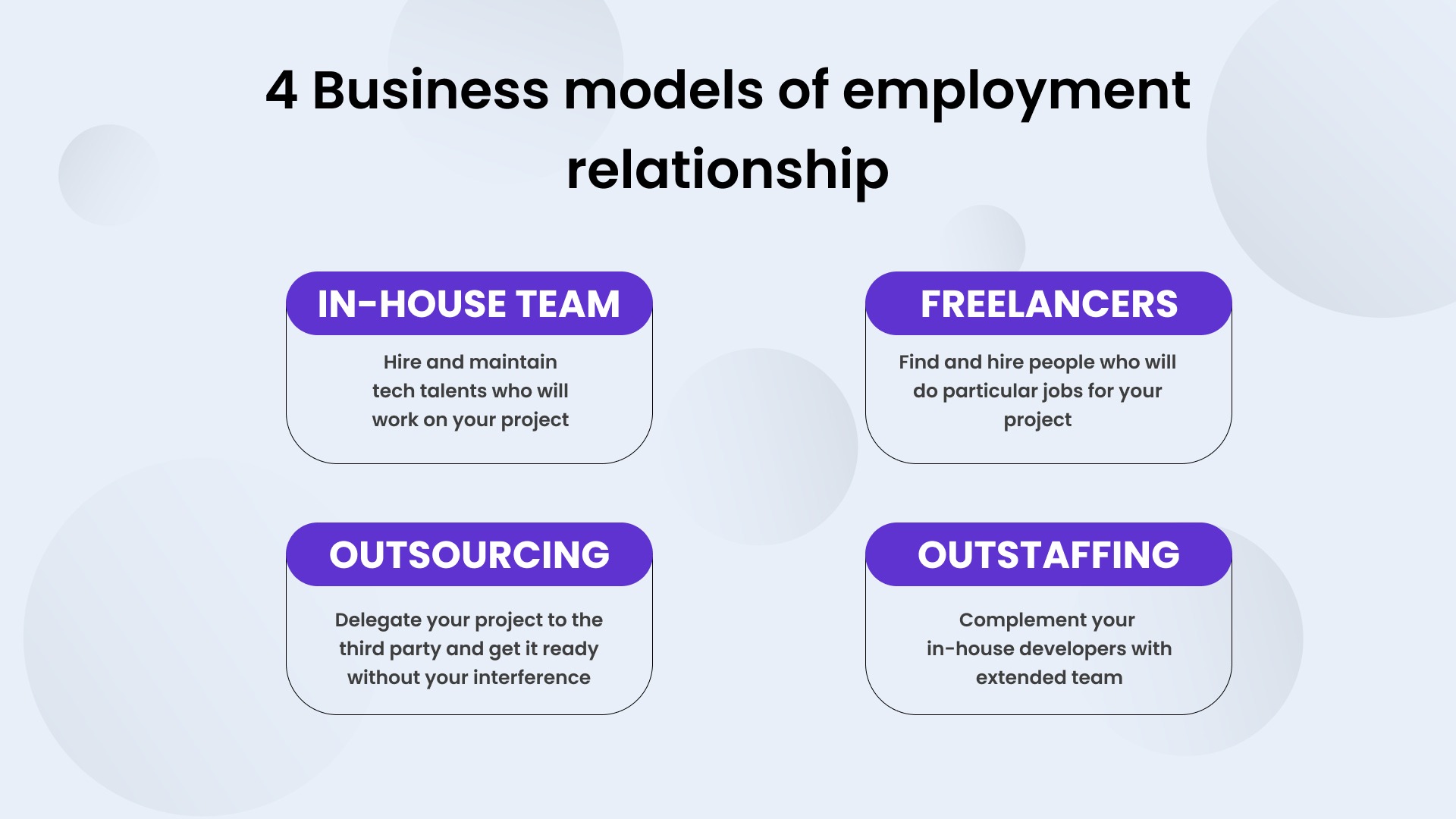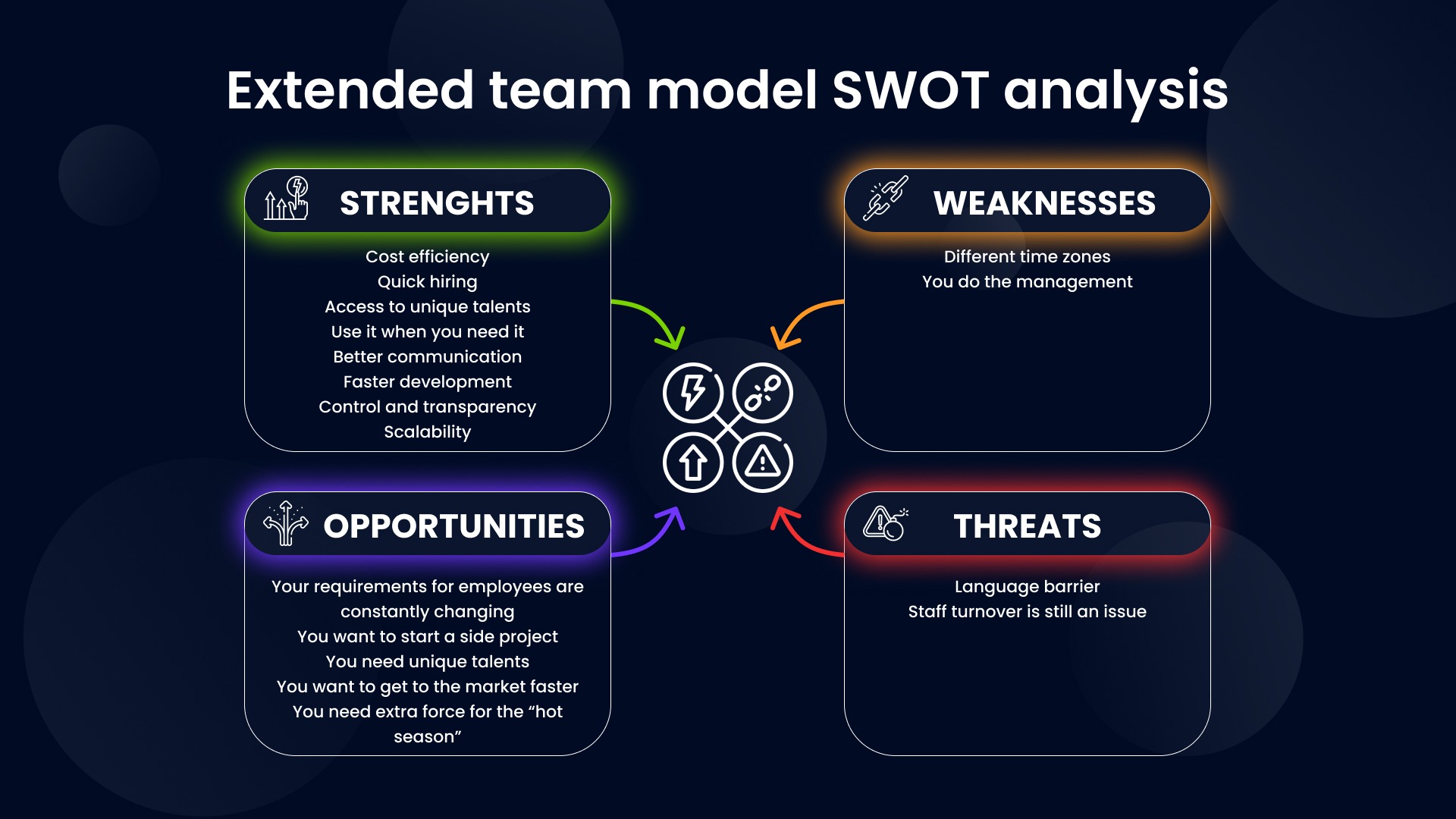
Around 65% of successful organizations take advantage of outsourcing, with IT services being in the top 3 sectors that are outsourced. Thanks to this business model, companies decrease costs, speed up time to the market, and develop apps they would never develop without offshore assistance. However, in some cases, outsourcing is not the best choice, and businesses seek something more, like the extended team model. This business approach is relatively new, so we have conducted its SWOT analysis for you to see if ETM is the first choice for your business needs.
What’s on the table?
Modern businesses have four main cooperation models with their employees.

In-house employment is when workers are hired and managed directly by the company. Employees can work in a brick-and-mortar office or remotely from their homes. As a rule, in-house workers are residents of the same country as the business.
Freelance cooperation is when workers are sought directly for doing a particular job in a project. Freelancers don’t sign contracts with the employer, they’re not a part of the core team, and they’re rarely entrusted with sensitive data or commercial secrets.
Outsourcing is when you hire a third party to do your project from scratch. Everything, starting from the management and up to the technology stack choice happens on the side of your contractor. You don’t have much control over the project, but you also don’t need to spend your time managing it too.
In 2019, the information technology outsourcing global market size has reached 92.5 billion dollars, and there are no signs of a downtrend. Outsourcing is the most popular business model for companies that want to get all the benefits of working with an offshore tech talent development team. This model is perfect for companies that don’t have an IT department of their own but need to cover some technical issues.
Unlike outsourcing which is designed to substitute your development team, outstaffing is here to complement your IT department. You can get a full-fledged dedicated team of developers, QA engineers, designers, and managers to work on your project, or you can choose an extended team model and hire just one or a couple of unique experts.
During the last few years, the extended team model has gained momentum. As it looks like a perfect type of remote cost-efficient cooperation between employers and employees, we decided to share with you its main peculiarities.
Extended team model SWOT
The team extension model, also known as staff augmentation is a way to expand the expertise and skill set of your in-house developers without hiring new workers. Talking metaphorically, your core team is a multipurpose framework, and your extended team is an evolving plugin that customizes your team’s performance to your business needs. The extended team model has its pros and cons, though. We have analyzed them by conducting a SWOT analysis.

Strengths
- Cost efficiency. Outsourcing your IT services to countries with lower wages is a safe and proven method to cut your expenses.
- Quick hiring. With the help of a contractor, you can find and onboard the required talents faster.
- Access to unique talents. By cooperating with a big staff augmentation company, you access a wide pool of talent.
- Use it when you need it. You can use an extra workforce only when you need it. You don’t have to maintain an augmented staff of in-house developers when there is a “low season.”
- Better communication. With ETM, the core team and extended team of your business work closely together, communicating directly. Thus, they can share experiences and build stronger interpersonal bonds, which is always better for the implementation of your business goals.
- Faster development. The better integration of the extended team into the work processes (including the use of unified repositories by your in-house developers and the extended team) speeds up the development.
- You can easily scale your business.
- More control and transparency. You know what your extended team is doing, what technologies they use, and even what their code looks like.
- Better performance. ETM helps you fill in all the talent gaps and becomes an efficient tool for developing high-performing teams.
Weaknesses
- Different time zones. Your extended team might have another GMT zone which might bring some inconveniences, like, your core team and the extended team will work together only for a limited time during the day. If you’re outsourcing offshore, bring this question up before you send a job offer to your new co-worker.
- You do the management. You have to manage and control your extended development team by yourself. There’s no intermediary link on the side of your contractor.
Opportunities
The ETM is a sharp decision in multiple cases. Here are just some examples of when an extended team model might become a brilliant opportunity for your business.
- You have a large project with evolving requirements for positions.
- You need to speed up the time to market.
- You want your in-house team to work on core business and need extra help with your side projects.
- Your project needs a highly specialized talent that you can’t find by yourself.
- You need extra force but don’t have a budget for maintaining new developers.
Threats
- Language barrier. Your new staff might not be fluent in English which can lead to miscommunication issues in the future. Appoint a video call with every extended team member before you hire them to double-check their English proficiency.
- Staff turnover is still an issue. Your new workers might quit your outsourcing contractor and automatically stop cooperating with you. Make sure that the company you choose as your partner has a low staff turnover and a good reputation on the market.
The only way to tackle all these threats at once is to cooperate with a reliable extended team provider who has vast hands-on experience in the market and a well-established HR brand. MWDN might be a wise choice – in 2021, we took fifth place in the “Best employer among IT companies in Ukraine” rating, and this year, we’re holding third place.
What’s the difference between outsourcing and the extended team model?
| Things in common | Distinctions |
|---|---|
| Outsourcing and ETM provide similar benefits for the business. These models are both cost-efficient as they help you take advantage of the geographical discrepancies in developers’ wages and get skilled tech talents for less money. Contractor companies that provide outsourcing or ETM take law compliances, payments, and taxation upon themselves. You don’t have to bother with these questions. | The outsourcing company offers a team to become your third-party contractor, while the extended team is an offshore part of your development team. When you hire an outsourcing company, you can’t access developers directly, you only interact with the project manager. When you deal with the extended team, your PM controls and manages the new developers directly. With outsourcing, you delegate the project and don’t need to participate in its development. The extended team requires your management and control. Outsourcing is a substitution for the IT department you don’t have. The extended team meaning is in complementing the department you already have. |
So, what should you choose?
It’s easy.
Do you want to give your money and forget about the project until it’s ready? Then, choose the outsourcing model.
Do you want to add new expertise to your core team without increasing the in-house staff? Then, opt for the extended team model.
If you don’t know what is best for your business, contact MWDN, and we will help you make the right choice!
